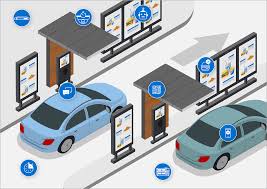Introduction
In today’s fast-paced world, customers demand quick, efficient, and seamless service experiences. Whether grabbing a coffee, picking up prescriptions, or ordering dinner, Drive Thru Systems have revolutionized how businesses deliver convenience. In Saudi Arabia, where retail and food industries are rapidly expanding, Drive Thru Systems are becoming a dominant service model — reshaping customer service expectations across multiple sectors.
This blog will delve into how Drive Thru Systems work, their implementation and adaptation in the Kingdom of Saudi Arabia, and why they are more relevant than ever in a post-pandemic, convenience-driven world.
Understanding the Drive Thru System
A Drive Thru System is a customer service model that allows individuals to receive goods or services without leaving their vehicle. Most commonly associated with fast food, drive thru setups now span pharmacies, banks, coffee shops, grocery pick-ups, and even COVID-19 testing centers.
The typical process includes:
- Entry to a designated lane.
- Voice or digital ordering via intercom or app.
- Payment through contactless or manual options.
- Collection of the product at a delivery window or kiosk.
These steps are optimized for speed, efficiency, and minimal physical interaction, which has become essential in today’s health-conscious society.
Evolution of Drive Thru Technology
The earliest Drive Thru services emerged in the 1930s in the United States, but over the decades, the technology and process have significantly evolved. Modern systems now integrate:
- AI-powered order-taking
- License plate recognition
- Mobile app integration
- Digital payment processing
- Real-time queue tracking
The focus has shifted from just quick service to personalized experiences, with some chains using customer data to suggest menu items and promotions at the drive-thru lane.
Drive Thru System in Saudi Arabia
The Drive Thru System in Saudi Arabia is experiencing remarkable growth, fueled by the country’s Vision 2030, which encourages innovation, modernization, and foreign investment in retail and services.
Fast-food brands like McDonald’s, Kudu, Hardee’s, and Starbucks were among the first adopters, but many local brands and service providers have followed suit.
Trends in the Kingdom:
- Pharmacies such as Al Nahdi now offer prescription pickups via drive-thru lanes.
- Banks and financial services are exploring Drive Thru ATMs and document collection points.
- Healthcare clinics offer sample collection and COVID-19 testing.
- Restaurants and cafes are designing stores with multiple drive-thru lanes.
The Saudi market is increasingly favoring businesses that provide contactless, fast, and automated solutions.
Benefits of Implementing Drive Thru Systems
There are numerous advantages for both customers and businesses when using Drive Thru services:
For Customers:
- Speed and convenience without leaving the car.
- Reduced waiting times compared to dine-in or walk-in services.
- Better hygiene and safety during health crises.
For Businesses:
- Increased order volume and customer satisfaction.
- Efficient labor use, especially with automation tools.
- Better adaptability for 24/7 operations.
Drive Thru Systems also help reduce congestion inside facilities, allowing smoother customer flow and improved service levels.
Industries Leveraging Drive Thru in Saudi Arabia
- Food & Beverage (F&B):
Quick service restaurants dominate this sector, but local Saudi restaurants are catching up fast. - Pharmaceuticals:
Pharmacies now offer drive-thru prescription services, refills, and medical consultations. - Retail & Grocery:
Grocery chains and mini-markets provide online order pick-up through drive-thru lanes. - Banking & Financial Services:
Saudi banks are exploring Drive Thru ATMs and form submission points. - Healthcare Services:
Diagnostic centers and clinics allow drive-thru blood collection, vaccine administration, and testing.
Key Components of a Modern Drive Thru System
Implementing a robust Drive Thru System requires several technical and operational components:
- Order Station (intercom or touchscreen)
- Queue Management Software
- Digital Signage
- Mobile App Integration
- Surveillance and Safety Cameras
- Automated Payment Gateways
- Customer Feedback Tools
Additionally, data analytics play a vital role in tracking wait times, peak hours, and customer preferences — leading to improved service and marketing strategies.
Challenges in Implementing Drive Thru Services
Despite its advantages, building and operating a Drive Thru System in Saudi Arabia comes with several challenges:
- Urban Planning Restrictions:
Not all locations can accommodate large drive-thru lanes. - Weather Conditions:
High summer temperatures require air-conditioned waiting areas or shaded lanes. - Initial Investment:
Infrastructure, equipment, and software can be costly upfront. - Training Staff:
Employees must be trained in multi-tasking and using automated systems. - Cultural Adoption:
For services like pharmacies or healthcare, not all customers are aware or ready for drive-thru options.
Innovations Driving the Future of Drive Thru
The future of Drive Thru lies in innovation and personalization. Some key trends include:
- AI-Powered Voice Ordering
- Facial Recognition for Order Recall
- Drone-Based Delivery at Drive Thru Points
- Blockchain-Based Secure Payments
- IoT Sensors for Real-Time Queue Management
In Saudi Arabia, where digital transformation is a national agenda, the scope for these technologies is vast and rapidly growing.
Drive Thru Design for Saudi Culture and Climate
Saudi Arabia’s unique geography and culture influence how Drive Thru Systems are designed and deployed:
- Multiple Language Interfaces: Arabic and English options must be available.
- Shaded Waiting Areas: Essential due to extreme heat.
- Prayer Timings Integration: Systems may need pauses or alerts.
- Gender-Sensitive Protocols: Special attention to privacy for female customers.
Businesses that respect and adapt to these cultural elements tend to build trust and customer loyalty faster.
Best Practices for Drive Thru Success
- Invest in Training:
Well-trained staff make the experience smooth and fast. - Optimize Order Flow:
Use software to monitor and improve peak time efficiency. - Use Customer Data Wisely:
Suggest upsells or loyalty points during transactions. - Ensure Accessibility:
Make sure your drive-thru is easy to access and navigate. - Promote Your Services:
Many customers still don’t know they can use a drive-thru for non-food services.
Conclusion
The Drive Thru System in Saudi Arabia is more than a passing trend. It is a powerful business model that addresses customer expectations for convenience, safety, and speed. By embracing technology, respecting cultural dynamics, and delivering value-driven experiences, Saudi businesses can use Drive Thru Systems to gain a competitive edge in the evolving service landscape.
From food and pharmacy to banking and health, every industry in the Kingdom has the potential to go drive-thru — and those who invest now will reap long-term benefits in customer satisfaction and operational excellence.
FAQs
1. What is a Drive Thru System?
A Drive Thru System allows customers to receive goods or services without leaving their vehicles, commonly used in food, pharmacy, and banking sectors.
2. Are Drive Thru Systems popular in Saudi Arabia?
Yes, they are rapidly growing in popularity, especially in food service, healthcare, and retail sectors, aligned with Vision 2030 goals.
3. How can small businesses implement Drive Thru?
Small businesses can start with basic infrastructure, mobile ordering apps, and clear queue signage to create a simple yet efficient drive-thru.
4. What are the major benefits for businesses?
Drive Thru Systems increase sales, improve customer satisfaction, reduce crowding, and offer contactless service options.
5. What technology is used in Drive Thru Systems?
Modern drive-thrus use AI, IoT, digital menus, mobile apps, cameras, and automated payment systems for better efficiency and personalization.





